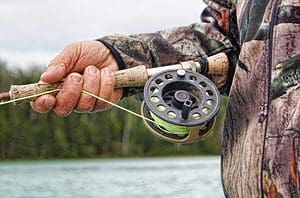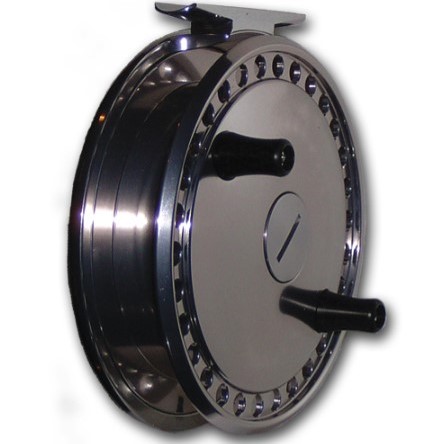Disclosure: Some posts contain affiliate links, which earn us a commission if you make a purchase through them. Positive Fishing © participates in various affiliate networks including the Amazon Services LLC Associates Program.
To many, centerpin fishing seems like an extremely old-fashioned fishing method. The use of a longer rod, coupled with a centrepin reel, takes time to learn, but few fishing tactics create more of a natural drift than “pinning.” Learning to pin would be in your best interest if you’re a Steelhead angler. You’ll find yourself landing more fish than you would on several other methods.
In this article, I will cover:
- What Is Centerpin Fishing?
- How do I Use a Centrepin Reel?
- When is it Smart to Use a Centerpin?
- Five Best Centerpin Reels
- Raven Matrix Centerpin Reel (Our Best Overall Pick!)
- Channelmay 4” CNC Reel (Our Best Budget-Friendly Pick!)
- Saion 4″/4.75″ Centre Pin (Our Most Versatile Pick!)
- Cabela’s Okuma Raw
- Ber Canada Summit Centerpin Reel
What is Centerpin Reel Fishing?
Centerpin fishing should be your top option if you’re planning on fishing below a bobber or float, which acts as an indicator. These reels have absolutely no drag, usually around 4 to 5.5 inches in diameter. It sits on a single “pin” in the center of the rod’s cork handle.
The rod used with a centrepin is usually around 11 to 13 feet long. The extra length helps anglers accomplish long drifts without getting hung up on anything throughout the water. Since the reel has no drag, it can spin forward and backward. The reel will allow the line to roll along with the speed of the river current easily, making a natural bait presentation.
How Do I Use A Centrepin Reel?

When you’ve attached your centerpin reel to your rod, you’ll notice that it might start spinning immediately. Unlike spin fishing or fly fishing, your reel is able to spin without any effort on your part. Therefore, you have to pay close attention to how much movement the reel has.
Once your line is in the water, that’s when the reel work begins. As your line drifts downstream, you can make long mends and let as much line out as you want. To control the pace at which the line is stripped, you need to “palm” the reel. Palming the reel is where you put your hand over the back of it and create as much tension as you would like.
If you feel a bite, put your hand on the reel to stop the fish from taking it, and that will “set” the hook. Also, you’re in charge of creating the drag in the midst of the fish with the fish. It takes some getting used to, but eventually, you’ll learn the exact amount of tension you need.
The most common bait used with a centerpin reel is an egg sac. Tie on a Balsa float, several split shots, and a swivel, and attach the egg sac to the hook. Since you have a row of split shots under the float, this makes sure your egg sac is the first thing to pass in front of the fish.
When is it Best (And Smart) to Use a Centrepin Reel?
If you’re targeting steelhead, salmon, or large trout on the river, using a centrepin will help you land fish. You can create the exact right drift and tension with one of these reels. Plus, the longer rod will make for a more efficient drift.
Essentially, any moving water would allow you to use a centrepin reel.
Raven Matrix Centerpin Reel – Our Best Overall Pick!

The Raven Matrix centrepin reel is a favorite for many fly fishing guides. Raven isn’t necessarily well-known in the general fishing world, but the centerpin community is quite familiar with the Matrix.
It has a quality black, bronze, or titanium backplate and a low-profile reel foot. The coin-slot tension screw is also a nice feature in case you run into any instances on the water where you need to make a change. The Matrix model is 4 and 3/4 inches in diameter. Plus, it has twin shielded ball bearings.
When setting up this reel, you can attach up to 50 yards of backing and 200 yards of 8-pound line. Depending on your preference, it’s possible to upgrade the bearings to ensure you’re getting the smoothest retrieval process.
Many anglers will attach the matrix reel to a 10 or 11-foot rod!
Most anglers love that this reel is almost entirely closed. Since you’re fishing this reel through moving water, you have the potential to get quite a bit of debris in the reel to mess up the flow and feel of things. Raven thought of many things that could go wrong and did their best to ensure the reel performs well at all times.
This reel is going to cost you $270 and is available in a 5″ 1/8 size also. Yes, it’s a more expensive option, but the quality is hard to beat.
Channelmay 4” CNC Reel – Our Best Budget-Friendly Pick!
In the world of fishing, affordability doesn’t always mean quality. Thankfully, Channelmay noticed that there needed to be a more affordable option, and they came through. It’s a CNC Machined Aluminum reel with a great balance. A properly balanced centrepin reel is going to make a world of difference.
You have 2+1 ball bearings and a disc drag system! The four options you have are 3/4, 5/6, 7/8, and 9/10. Depending on the length and weight of your rod, make sure you choose the proper reel that will balance your rod best.
The best part of this reel is that it’s only going to cost you $30!
Saion 4″/4.75″ Centerpin – Our Most Versatile Pick!
Saion’s 4.75 inch Centerpin Reel is a great versatile and affordable option for anglers. Again, Saion isn’t one of those brands that anglers are extremely familiar with, but don’t let the unfamiliarity dissuade you. Saion knows how to make a great reel.
With this option, you’ll have stainless steel ball bearings and an on/off ratchet with a Clicker and double wooden handles. This is an old school looking reel with some high-quality technology.
Another nice aspect of this reel is that the majority of this reel is closed. You aren’t going to get the unnecessary sand or dirt in this reel that you might find in other, more affordable options. It’s a great-looking reel and can easily handle salmon, trout, or steelhead! Take it on your next adventure, and you’ll be more than happy.
Thankfully, this reel is only going to cost you around $60. Saion also offers a 4″ Fishing Centerpin, in the same range, which is equally good but with a smaller arbor size. This 4″ reel is great for float and trotting for general coarse fishing and is around 20% cheaper than the 4.75″ Saion.
Cabela’s Okuma Raw
Reputable brands aren’t always easy to find in the world of centrepin reels. However, Cabela’s recently made their own version of a centrepin reel that works extremely well. The reel is an Okuma design and is marketed under the full name of Okuma Raw II Mooching & Float Reel. It has a fully machined, beautifully designed aluminum alloy frame.
The German stainless steel ball bearings create an extremely smooth performance. The diameter is 4.5 inches and is able to handle about 50 yards of backing and 200 yards of 8-pound line.
This reel also has a CRC corrosion-resistant coating, two stainless steel ball bearings, and an on/off drag. It’s extremely smooth, so you don’t have to worry about anything getting stuck in your reel and ruining your drifts.
Another aspect of this reel that’s appealing is that Cabela’s offers a 1-year warranty. This allows you to fish this reel with peace of mind. Target those large trout or Steelhead, and don’t worry about all of the tension and battles it’s going to be put through.
It’s hard not to enjoy fishing with this reel! You’ll receive 13 inches in recovery every turn, and it weighs 8.25 ounces. It’s a mid-range price reel, making it a popular choice for many anglers.
BER Retro 4.5 Centerpin Reel
BER Centerpin reels have a bearing seat that doesn’t need time to “start up.” This means that there is no initial spool inertia, which can cause a fish to shake the hook. These reels are made of Canadian materials, and you won’t lose quality!
The reel is made of aircraft-grade aluminum, and the CNC equipment used to machine it, coupled with CAD design software, ensures you can work a river with precision fishing. The anodized finishing gives this reel some necessary quality that can be missing in other reels on the market.
One of the biggest downsides of this reel is its price tag…… $400. Yes, it’s extremely expensive, but the quality of this reel is hard to beat. One important aspect of Ber reels is that they can be fully customized by the angler!
Tip: Centerpin reels have a clicker but it is not used whilst fishing, it’s used for transporting the reel.
What is the Difference Between a Centerpin and a Fly Reel?

They are both centrepin reels, but true centrepin reels are usually larger in diameter than fly reels. A Centerpin does not use a mechanical drag feature like Fly reels.
The major difference is that a fly reel could not function as a trotting reel very well, but a centrepin reel will work fine as a fly reel……..which many trout anglers do, in fact, use.
Final Thoughts
The beauty of centrepin fishing is that not many people do it anymore. As a result, fish don’t see these types of natural drifts daily. Trout and steelhead are known to be challenging to land, so presenting a natural fall and flow of your bait can often fool them when other methods fail.
Why not give yourself the best chance to land some of these fish? Centerpin fishing is your answer, and it’s so “old school”!
Look to match your centerpin to a fly rod suited for trout fishing, and make sure that you always choose a quality trout fishing line to get the best results.
- Wading Belt Essentials: Ensuring Safer Fishing - January 9, 2024
- Fishing For Catfish (Top Tips, Bait, & Gear To Catch The Big 3) - October 20, 2022
- Fishing Line Strength Vs. Diameter Chart: Why Is It Important? - October 12, 2022




